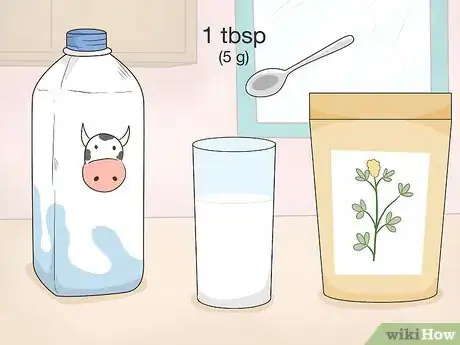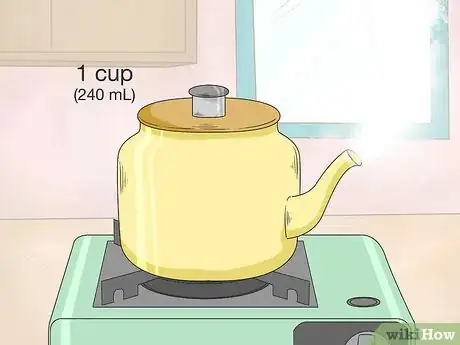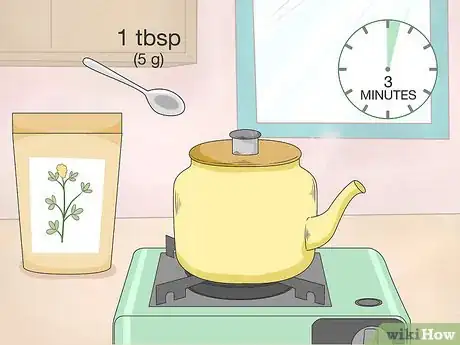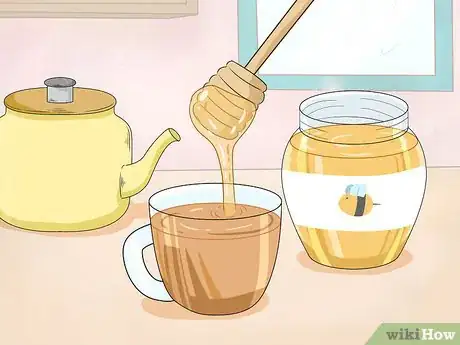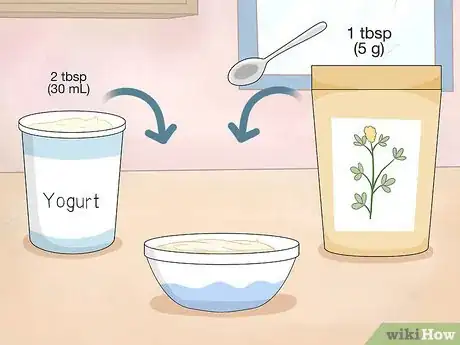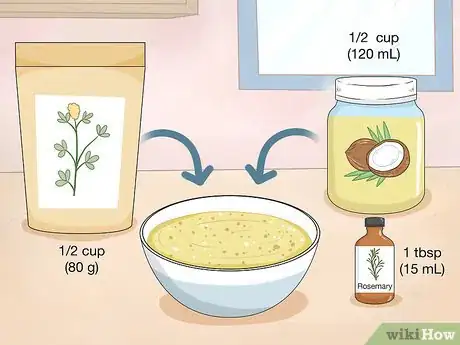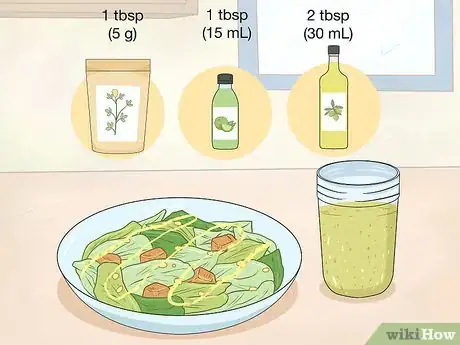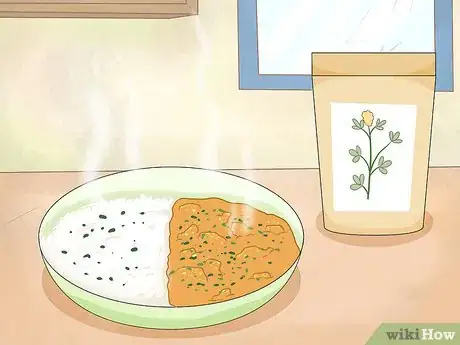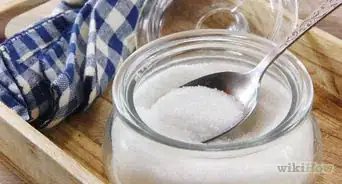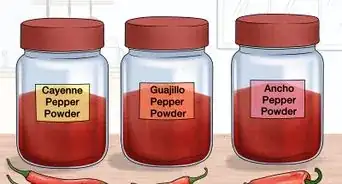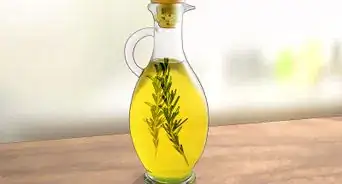This article was co-authored by John Burson. John Burson is a Certified Nutritionist, Licensed Herbalist, and Certified Personal Trainer. With over 25 years of experience, John specializes in helping clients lose weight and live healthier lives. John graduated magna cum laude and received a Bachelor’s degree in Business and Marketing from Grand Canyon University. He has also earned Thumbtack Top Pro honos for three consecutive years.
There are 11 references cited in this article, which can be found at the bottom of the page.
This article has been viewed 76,817 times.
Fenugreek powder, also known as methi, is an herb that has long been used in India and North Africa. It is said to have a number of health benefits, such as nourishing skin and hair. The most common way to take fenugreek powder is by mixing it into milk, water, or tea at least once a week. It can also be mixed into a paste and applied to your skin or scalp for a more direct benefit. However, fenugreek powder is more than a health remedy and is frequently used as a flavorful spice in soups, curries, and other dishes. If you choose to use fenugreek powder, let your doctor know if it’s safe with any medications or conditions you have.
Steps
Drinking Fenugreek Powder
-
1Drink the powder with milk or water for a simple use. Mix 1 tablespoon (5 g) of the powder into a glass of about 1 cup (240 mL) of water or milk. The water or milk can be left cold or warmed up first if you prefer it that way. It’s a quick and easy way to get the possible benefits of fenugreek powder, including lowered appetite and blood sugar levels. You could also eat the powder plain, but putting it in a drink makes it more enjoyable.[1]
- The powder mix can be taken up to twice a day. Try drinking it once in the morning, then again at night.
-
2Boil a pot of water if you want to make tea. Fill a kettle with at least 1 cup (240 mL) of water. Let it heat up on a stove or electric plate until it’s bubbling and hot. Wait to put the fenugreek powder in until the water reaches a boil.[2]
- If you don’t have a kettle handy, you could boil water in a pot on the stove. Find a safe way to transfer it to a teapot or glass.
Advertisement -
3Steep the fenugreek powder in the tea water for 3 minutes. Pour the water from the kettle into a teapot or another container. Then, add about 1 tablespoon (5 g) of the powder. After stirring it, cover the container and wait.[3]
- Since you’re using powder, you won’t need to strain the tea before drinking it. The powder will dissolve in the water. If you steep leaves or seeds, pour the tea through a strainer before drinking it.
-
4Serve the tea with sweeteners if you desire. The powder will give it a taste somewhat like maple syrup, so you could add some additional flavoring if you prefer. Honey and stevia are a few good ways to give the tea a lighter, gentler flavor. Fenugreek tea is often used to treat inflammation, aid digestion, and improve weight loss.[4]
- You can drink the tea once or twice a day to get any potential benefits it offers. It’s meant to be used in place of fenugreek powder mixed into water or milk.
Using Fenugreek Powder on Your Skin
-
1Mix fenugreek powder into water to make a face wash. Take 1 tablespoon (5 g) of fenugreek powder and stir it into about 2 tablespoons (30 mL) of water. Use lukewarm water so the wash feels comfortable on your face. You could also use milk or even yogurt to make the face wash more beneficial. Keep stirring the fenugreek powder mixture until it forms a paste.[5]
- Face wash pastes made with fenugreek powder are said to treat skin problems like acne.
-
2Combine the powder with coconut oil if you need a moisturizer. Pour up to ½ cup (80 g) of fenugreek powder into a mixing bowl. Stir in about 1⁄2 c (120 mL) of liquid coconut oil until it turns into a paste. You could also add essential oils, such as 6 drops of rosemary oil, or 1 tablespoon (15 mL) of aloe vera gel. Aloe vera gel and essential oils are often used to clean and protect skin.[6]
- Another option is to use lemon juice in place of the coconut oil or add amla juice to the mixture. Amla is a type of fruit also called Indian gooseberry and is used to promote hair health.
-
3Apply the paste to your skin using a cotton ball or your hand. Dab the wash or moisturizing mixture onto acne or other problematic areas first. Use a cotton ball to ensure those areas get covered. If you’re planning on wearing the paste as a face mask, spread it across your entire face. Make sure your skin is completely covered.[7]
- The paste can also be applied to your scalp to condition your hair and encourages hair growth. Pastes with yogurt, lemon juice, or coconut oil work best since they are easier to spread.
-
4Wash the fenugreek mixture off after at least 20 minutes. If you have the time, wait 40 minutes or more to ensure the face wash or moisturizer has plenty of time to work. It can be a little messy, so you may want to cover your clothing up with a towel if the paste doesn’t adhere well to your skin. Then, rinse all of the paste off under warm water.[8]
- For the best result, reapply the fenugreek paste mixture 2 or 3 times a week. Space out the applications evenly throughout the week.
Cooking with Fenugreek Powder
-
1Season vegetables by sprinkling them with fenugreek powder. Toss vegetables with about 1 tablespoon (5 g) of the powder. Alternatively, mix the powder into a dressing to use on a salad. For example, combine 1 tablespoon (5 g) of fenugreek powder with 1 tablespoon (15 mL) of lime juice and 2 tablespoons (30 mL) of olive oil. You could also add honey and salt for additional flavoring.[9]
- The powder can be added directly to vegetables or a dressing. It has a slightly sweet, nutty flavor similar to maple syrup. Honey and salt are good options for hiding the flavor if you don’t like it.
- Sprouted fenugreek seeds and leaves are more commonly used in salads. If you don’t have them, the powder is a fine substitute.
-
2Mix the powder in for flavor if you’re making a soup. Treat fenugreek powder like any other spice or herb in your cupboard. You could make a brown lentil soup, for example. Cook about ½ cup (100 g) of lentils as well as half a red onion and 3 cloves of garlic in water. Blend up the powder with other seasonings, such as ½ teaspoon (0.9 g) of coriander, ½ teaspoon (1.2 g) of black pepper, ¼ teaspoon (0.5 g) cayenne pepper, ½ teaspoon (1 g) of turmeric, and 1/4 teaspoon (0.7 g) of cinnamon. Add it to the lentils and let the soup simmer.[10]
- There are all kinds of soups you can make with the powder. It’s a common seasoning in lentil soup, but try adding it to a soup made from fruits or vegetables.
-
3Stir the powder into food like curry if you need to season it. Fenugreek powder has traditionally been used as a seasoning for curry dishes. It adds flavor when mixed into a sauce or rubbed directly onto meat. For instance, fry 4 chicken thighs in oil, then add 2 teaspoons (1.7 g) of the powder along with spices like 1 tablespoon (1.8 g) of coriander, 1 teaspoon (2.7 g) of chili powder, and 1 teaspoon (2 g) of turmeric.[11]
- Search for different recipes to try. Fenugreek powder is a good seasoning for Berbere chicken, for example, but it can also be used to spice up vegetable or rice dishes.
-
4Use the powder for flavoring if you’re making dessert. Rice pudding is one popular way to incorporate fenugreek powder into a dessert. Start by boiling about 1 cup (200 g) of basmati rice in 4 cups (950 mL) of milk. Then, add about 4 tablespoons (16.8 g) of sugar along with the powder and any other spices you plan on using. Let the rice simmer for about 20 minutes while stirring it to prevent it from burning.[12]
- For example, try mixing ¼ teaspoon (0.7 g) cinnamon, ¼ teaspoon (0.5 g) of cardamom, and ¼ teaspoon (1.3 g) of fenugreek powder.
- The powder could also be used to flavor cakes, cookies, and all sorts of other desserts. Some people don’t like the fenugreek flavoring in sweet food, but it often makes a dessert sweeter and more unique without having to rely on a ton of sugar.
- You can also incorporate powdered fenugreek in your pancakes and bread.
Expert Q&A
-
QuestionCan we eat fenugreek seeds directly?
 John BursonJohn Burson is a Certified Nutritionist, Licensed Herbalist, and Certified Personal Trainer. With over 25 years of experience, John specializes in helping clients lose weight and live healthier lives. John graduated magna cum laude and received a Bachelor’s degree in Business and Marketing from Grand Canyon University. He has also earned Thumbtack Top Pro honos for three consecutive years.
John BursonJohn Burson is a Certified Nutritionist, Licensed Herbalist, and Certified Personal Trainer. With over 25 years of experience, John specializes in helping clients lose weight and live healthier lives. John graduated magna cum laude and received a Bachelor’s degree in Business and Marketing from Grand Canyon University. He has also earned Thumbtack Top Pro honos for three consecutive years.
Certified Nutritionist Definitely! Feel free to add fenugreek to your soups, baked goods, salad, and curry. Just keep in mind that the seeds taste better when they're roasted or mixed with other spices.
Definitely! Feel free to add fenugreek to your soups, baked goods, salad, and curry. Just keep in mind that the seeds taste better when they're roasted or mixed with other spices.
Warnings
- Fenugreek is a natural supplement that can be risky for pregnant women and anyone taking medication. To avoid complications, talk with your doctor before using fenugreek powder.[14]⧼thumbs_response⧽
References
- ↑ https://www.ncbi.nlm.nih.gov/pubmed/19839001
- ↑ https://www.ncbi.nlm.nih.gov/pmc/articles/PMC4525133/
- ↑ https://stylesatlife.com/articles/fenugreek-powder-benefits/
- ↑ https://stylesatlife.com/articles/fenugreek-powder-benefits/
- ↑ https://stylesatlife.com/articles/fenugreek-powder-benefits/
- ↑ https://www.mapsofindia.com/my-india/india/21-mind-blowing-benefits-of-fenugreek-seeds-for-skin-hair-and-health
- ↑ https://www.ayurtimes.com/home-remedies-for-glowing-skin/
- ↑ https://theindianspot.com/fenugreek-mask-clear-bright-skin/
- ↑ https://www.foodpleasureandhealth.com/blog/2014/11/sprouted-fenugreek-salad.html
- ↑ https://www.bbc.co.uk/food/recipes/spicy_lentil_soup_with_91081
- ↑ https://kitchen.nine.com.au/recipes/30-minute-fenugreek-chicken-curry/83144a13-3558-40f2-8eb1-85facdd9325b
- ↑ https://food.nomadicboys.com/nepalese-kheer-rice-pudding-recipe/
- ↑ https://nccih.nih.gov/health/fenugreek
- ↑ https://nccih.nih.gov/health/fenugreek
